Round The World and other travels
A frequent flyer's collection of trip diaries
This is: Russia & Sweden 2014
Russia's window on Europe
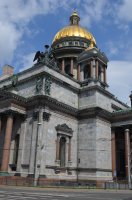 |
| ABOVE: Just steps away from our hotel, St Isaac's Cathedral |
By lunchtime on Wednesday, we had repositioned to Russia's second city and its cultural capital. Founded as St Petersburg in 1703, it became Petrograd in 1914 and Leningrad in 1924, before reverting to its original name in 1991. (The airport's IATA code remains 'LED' to this day.) The city is situated on the Gulf of Finland, an arm of the Baltic Sea, less than 200 miles' flying distance from Helsinki. It was constructed across more than a hundred islands in the Neva River delta, linked by canals and arched bridges. Goethe said the water reminded him of Venice, and the stately embankments of Paris. It is considered to be a masterpiece of urban design with its geometric lines and perfectly planned architecture - almost too European to be Russian. Indeed, during the transfer from the airport to our hotel, I found myself constantly thinking how mainstream-European it seemed in comparison to Moscow. I felt that I might be approaching the city centre of, say, Copenhagen. At the same time, I was catching occasional, teasing glimpses that tended to confirm that I was passing through the streets of what is widely acknowledged as one of the world's most beautiful cities.
 Despite being a huge urban sprawl that is home to
five million people, St Petersburg has a relatively compact central
historic district. After a short interlude to get settled into our new
base at the Renaissance Baltic, we were ready to set out on another gloriously sunny and hot afternoon. The first priority was
to have some lunch and we soon found a branch of Teremok, a
fast-food chain operating in Russia's two largest cities and
specialising in sweet and savoury varieties of blini (Russian
crepes).
Despite being a huge urban sprawl that is home to
five million people, St Petersburg has a relatively compact central
historic district. After a short interlude to get settled into our new
base at the Renaissance Baltic, we were ready to set out on another gloriously sunny and hot afternoon. The first priority was
to have some lunch and we soon found a branch of Teremok, a
fast-food chain operating in Russia's two largest cities and
specialising in sweet and savoury varieties of blini (Russian
crepes).
In a change to our planned itinerary, we decided to spend the afternoon visiting the Peter and Paul Fortress. The thinking behind the change was that there were indications that the fine weather might not be set to continue, and the fortress was largely an open-air location where part of the enjoyment would derive from the views back to the city. In any case, it was a thoroughly appropriate move: this was, after all, the very place where St Petersburg was born. We travelled on the metro out to Gorkovskaya station, located near the zoo. The experience was similar to the Moscow system, except that here the escalators were even longer: based on the average depth of all stations on the network, the St Petersburg metro is the deepest in the world. A short walk through the park then brought us to a footbridge leading to Hare Island, which is largely given over to the fortress.
We entered the fort on the eastern side via St. John’s Gate and the outer fortifications, then proceeded through St. Peter’s Gate to the inner fortress. Buying tickets for the boardwalk along the top of the southern wall proved to be an inspired move, as it gave some wonderful views across the Neva to the city itself, while to our right, it provided an overview of buildings such as the Artillery Arsenal, the Engineer’s House, the pink and white Commandant’s House, the imposing Grand Ducal Burial Chapel, the Boat House (now a very grand-looking ticket office) and the main attraction, the Cathedral of Saints Peter and Paul. This highly unusual Russian Orthodox church was without the characteristic bulbous domes, graced instead by a single, slender, gilded spire (identical, incidentally, to that crowning the Admiralty building across the river, except for the angel crown and golden cross). The cathedral interior was also atypical, with the baroque iconostasis (the screen separating the nave from the sanctuary in an Orthodox church) adorned by free-standing statues. The church also featured a pulpit, apparently used only once in 1901 to excommunicate Leo Tolstoy for denouncing the Church.
| Peter & Paul Fortress | |||||
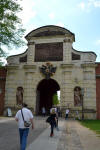 |
 |
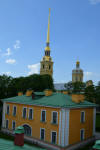 |
 |
 |
 |
 |
 |
 |
 |
||
| Sts Peter & Paul Cathedral | |||||
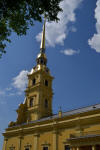 |
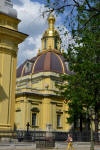 |
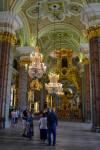 |
 |
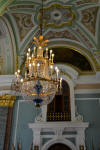 |
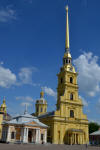 |
 |
|||||
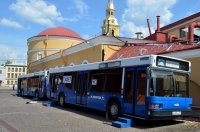 |
| ABOVE: Public transport or public convenience? |
We eventually left the complex via the Mint and the War Ministry Archives building, passing the somewhat bizarre sight of a couple of (presumably retired) single-deck buses that had gained a new role serving as public toilets!
We walked all the way back to the Renaissance Baltic, crossing a total of three bridges and passing the former Stock Exchange building that is now the Central Navy Museum, the Zoological Museum, and twin, red-painted lighthouses known as the Rostral Columns. As we crossed the last of the three bridges, Dvortsovy Most, we had some fine views of the State Hermitage Museum, which we would be exploring in detail the following day. Bruce reminded me of the St Petersburg tradition of raising the bridges: many of the city's important crossings are raised, drawbridge-style, from around 1am to 5am to permit the passage of ships. Late-night revellers need to be sure that they have a viable route home if they don't want to get stranded, as the metro also shuts down during similar hours!
The final part of the walk took us past the Admiralty building and St Petersburg's best-known monument to Peter the Great, the statue of the Bronze Horseman.
 |
 |
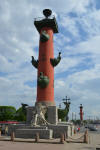 |
 |
 |
 |
 |
 |
 |
 |
 |
Back at base, and after a short pause to recover from the afternoon's exertions, we decided to sample the hotel's sixth-floor Summer Terrace as a venue for pre-dinner cocktails. While it was very pretty and provided stunning views of St Isaac's, the terrace offered limited protection from the strong sun and we both knew that we would be in danger of frying. We had one drink in the indoor section, but as this was completely lacking in atmosphere, we relocated to the excellent lobby bar for seconds and for some light evening sustenance.
I already felt comfortable with this new destination and was keen to get to know it a little better the next day.